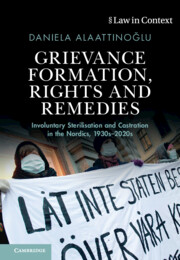 Grievance Formation, Rights and Remedies
Grievance Formation, Rights and Remedies from Part II - A Question of Rights?
Published online by Cambridge University Press: 18 August 2023
This chapter analyses the Swedish sterilisation laws of 1934 and 1941, castration law of 1944 and sterilisation precondition in the gender recognition act of 1972. More specifically, it considers their establishment, abolition and partial remedy. Exploring both written sources and interviews, the chapter uncovers the processes leading to the compensation acts of 1999 and 2018, and how (particularly trans) victims have mobilised for, and accessed, remedies. The chapter discloses an underlying tension between the limited legal admission of responsibility and the remedies established as ex gratia compensation schemes. It compares the unequal remedies given to each different victim group against their diverging degree of mobilisation. In order to understand their dissimilar recognition and redress, the chapter analyses how grievances have formed and been individually, collectively, publicly and/or institutionally recognised for the different groups. In doing so, it illustrates how the victims’ claims have aligned with a master frame of rights and achieved legal and socio-cultural resonance to diverging degrees
To save this book to your Kindle, first ensure no-reply@cambridge.org is added to your Approved Personal Document E-mail List under your Personal Document Settings on the Manage Your Content and Devices page of your Amazon account. Then enter the ‘name’ part of your Kindle email address below. Find out more about saving to your Kindle.
Note you can select to save to either the @free.kindle.com or @kindle.com variations. ‘@free.kindle.com’ emails are free but can only be saved to your device when it is connected to wi-fi. ‘@kindle.com’ emails can be delivered even when you are not connected to wi-fi, but note that service fees apply.
Find out more about the Kindle Personal Document Service.
To save content items to your account, please confirm that you agree to abide by our usage policies. If this is the first time you use this feature, you will be asked to authorise Cambridge Core to connect with your account. Find out more about saving content to Dropbox.
To save content items to your account, please confirm that you agree to abide by our usage policies. If this is the first time you use this feature, you will be asked to authorise Cambridge Core to connect with your account. Find out more about saving content to Google Drive.